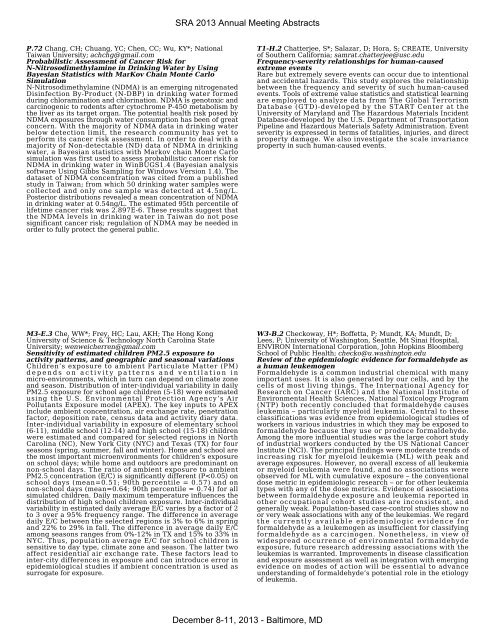Abstracts (PDF file, 1.8MB) - Society for Risk Analysis
Abstracts (PDF file, 1.8MB) - Society for Risk Analysis
Abstracts (PDF file, 1.8MB) - Society for Risk Analysis
Create successful ePaper yourself
Turn your PDF publications into a flip-book with our unique Google optimized e-Paper software.
SRA 2013 Annual Meeting <strong>Abstracts</strong><br />
P.72 Chang, CH; Chuang, YC; Chen, CC; Wu, KY*; National<br />
Taiwan University; achchg@gmail.com<br />
Probabilistic Assessment of Cancer <strong>Risk</strong> <strong>for</strong><br />
N-Nitrosodimethylamine in Drinking Water by Using<br />
Bayesian Statistics with MarKov Chain Monte Carlo<br />
Simulation<br />
N-Nitrosodimethylamine (NDMA) is an emerging nitrogenated<br />
Disinfection By-Product (N-DBP) in drinking water <strong>for</strong>med<br />
during chloramination and chlorination. NDMA is genotoxic and<br />
carcinogenic to rodents after cytochrome P-450 metabolism by<br />
the liver as its target organ. The potential health risk posed by<br />
NDMA exposures through water consumption has been of great<br />
concern. With the majority of NDMA data in drinking water<br />
below detection limit, the research community has yet to<br />
per<strong>for</strong>m its cancer risk assessment. In order to deal with a<br />
majority of Non-detectable (ND) data of NDMA in drinking<br />
water, a Bayesian statistics with Markov chain Monte Carlo<br />
simulation was first used to assess probabilistic cancer risk <strong>for</strong><br />
NDMA in drinking water in WinBUGS1.4 (Bayesian analysis<br />
software Using Gibbs Sampling <strong>for</strong> Windows Version 1.4). The<br />
dataset of NDMA concentration was cited from a published<br />
study in Taiwan; from which 50 drinking water samples were<br />
collected and only one sample was detected at 4.5ng/L.<br />
Posterior distributions revealed a mean concentration of NDMA<br />
in drinking water at 0.54ng/L. The estimated 95th percentile of<br />
lifetime cancer risk was 2.897E-6. These results suggest that<br />
the NDMA levels in drinking water in Taiwan do not pose<br />
significant cancer risk; regulation of NDMA may be needed in<br />
order to fully protect the general public.<br />
T1-H.2 Chatterjee, S*; Salazar, D; Hora, S; CREATE, University<br />
of Southern Cali<strong>for</strong>nia; samrat.chatterjee@usc.edu<br />
Frequency-severity relationships <strong>for</strong> human-caused<br />
extreme events<br />
Rare but extremely severe events can occur due to intentional<br />
and accidental hazards. This study explores the relationship<br />
between the frequency and severity of such human-caused<br />
events. Tools of extreme value statistics and statistical learning<br />
are employed to analyze data from The Global Terrorism<br />
Database (GTD)-developed by the START Center at the<br />
University of Maryland and The Hazardous Materials Incident<br />
Database-developed by the U.S. Department of Transportation<br />
Pipeline and Hazardous Materials Safety Administration. Event<br />
severity is expressed in terms of fatalities, injuries, and direct<br />
property damage. We also investigate the scale invariance<br />
property in such human-caused events.<br />
M3-E.3 Che, WW*; Frey, HC; Lau, AKH; The Hong Kong<br />
University of Science & Technology North Carolina State<br />
University; wenweicherren@gmail.com<br />
Sensitivity of estimated children PM2.5 exposure to<br />
activity patterns, and geographic and seasonal variations<br />
Children’s exposure to ambient Particulate Matter (PM)<br />
depends on activity patterns and ventilation in<br />
micro-environments, which in turn can depend on climate zone<br />
and season. Distribution of inter-individual variability in daily<br />
PM2.5 exposure <strong>for</strong> school age children (5-18) were estimated<br />
using the U.S. Environmental Protection Agency’s Air<br />
Pollutants Exposure model (APEX). The key inputs to APEX<br />
include ambient concentration, air exchange rate, penetration<br />
factor, deposition rate, census data and activity diary data.<br />
Inter-individual variability in exposure of elementary school<br />
(6-11), middle school (12-14) and high school (15-18) children<br />
were estimated and compared <strong>for</strong> selected regions in North<br />
Carolina (NC), New York City (NYC) and Texas (TX) <strong>for</strong> four<br />
seasons (spring, summer, fall and winter). Home and school are<br />
the most important microenvironments <strong>for</strong> children’s exposure<br />
on school days; while home and outdoors are predominant on<br />
non-school days. The ratio of ambient exposure to ambient<br />
PM2.5 concentration (E/C) is significantly different (P
















